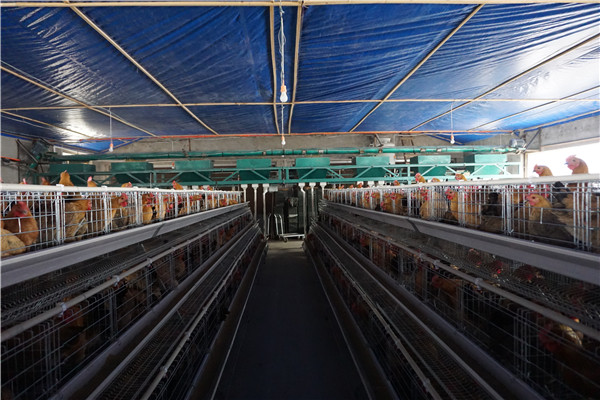Effect of air and ventilation on laying hens
1. The source and harm of harmful substances in chickens in the air The producers engaged in raising chickens must establish a firm idea that they should be able to provide fresh air to the chickens in the first place. First of all, you should understand and master the relevant basic knowledge.
(1) Water vapor content and source in the house In general, the amount of water vapor in the house is larger than the outside. The main sources are: 1 Water vapor enters the house with air, the water vapor content in the house and the area of the house, weather, temperature, etc. related. For example, in a dry area, air is dry and the house is relatively dry; in the rainy season or in the rainy season, the amount of water vapor in the air increases, and the humidity in the house also increases. 2 The water vapor exhaled by the flock accounts for approximately 75% of the total volume of water in the house. When shenwen was at 16°C, caged and bred layers with a body weight of 1.5 to 1.7 kg weighed 5.1 grams and 5.8 grams per kilogram of body weight per hour, respectively. When the shen temperature was 13°C and 35°C, each chicken exhaled 113 ml and 218 ml of water vapor per day, and the chicken manure also contained a lot of moisture, which also increased the amount of water vapor in the house after evaporation. 3 Floor, wall, sink And the amount of moisture evaporation from the herbage accounts for 10% to 15% of the total amount of water vapor. These water vapors increase the humidity or cause pollution. Only through ventilation can reduce the humidity inside the house and keep the air in the house fresh.
(2) The source of harmful substances in the air in the house 1 The unit of the gas content: The harmful gas in the air of the house is very small, generally measured in parts per million, for example, 0.13 parts per million %, generally expressed as 13 mg/l. 2 Ammonia (NH3): Ammonia is produced mainly by nitrogenous substances such as feces, feed, and bedding, which are decomposed by anaerobic bacteria. High temperature and high humidity will accelerate the production of ammonia; poor management, poor ventilation can greatly increase the ammonia content inside the house, such as closed chicken house, stop ventilation at night (close the fan), ammonia concentration can be as high as 80 ~ 90 Mg/l. Ammonia is water-soluble and has a pungent odor. Therefore, the wet ground, water vapor, dust in the air, and the mucous membranes and conjunctiva of humans and chickens are easily dissolved and absorbed. The lowest concentration that can be felt is 5.3 mg/l. Although the proportion of ammonia gas is small, it is mainly distributed within the reach of the flock because it is produced on the ground. The concentration of ammonia in the room should not exceed 20 mg/l. 3 Hydrogen Sulfide (H.S.): The hydrogen sulfide in the air of the house is produced from the decomposition of sulfur-containing organic matter, which can generate large amounts of hydrogen sulfide when the egg is spoiled or when the flock is indigestible. This gas has a strong odor smell and the lowest concentration of odor produced is 0.16 mg/L; the ratio is significant, so the concentration near the ground is high. The allowable concentration of hydrogen sulfide in the house should not exceed 10 mg/l. As long as we pay attention to ventilation, timely elimination of waste in the house, and strengthen management, it is generally not easy to exceed the allowable concentration. 4 Carbon dioxide (CO.): The atmosphere contains 0.03% to 0.04% of carbon dioxide, which can be up to 0.15% and sometimes even up to 0.5%, mainly due to exhaled chickens. A caged egg of 1.5 to 1.7 kilograms can exhale 1.7 cubic meters of carbon dioxide per hour, which corresponds to 2 cubic meters of chicken. The allowable concentration of carbon dioxide in the house is 0.15%, which is generally less than such hazards. It is generally believed that if the concentration of carbon dioxide in the house does not exceed 0.2%, harmful gases in the house will not exceed the requirements of the hygiene standards.
(3) The influence of harmful substances in the air in the house has already been mentioned. Ammonia has strong water solubility and is easily adsorbed on mucosa and conjunctiva. If the amount of adsorption is not large, the time is not long, it is sucked into the human body easily become urea excreted. On the contrary, if the concentration of ammonia exceeds the allowable amount, the longer the time, the greater the hazard. Typical examples are rarely seen in the production of chickens, so they are not listed one by one. The chronic toxic effect of ammonia on chickens is to reduce appetite, cause nutritional deficiencies, and thus degrade production performance. Chickens are particularly sensitive to ammonia and cause pulmonary congestion and edema after inhalation, increasing chicken susceptibility to Newcastle disease. Hydrogen sulphide is very toxic. At high concentrations, the toxicity is no less than that of hydrocyanic acid. After contact with the respiratory mucosa, it produces a series of reactions that lead to hypoxia. Under the effect of lower concentration of hydrogen sulfide, the chicken's constitution can be weakened, its resistance to disease decreased, and conjunctivitis, inflammation of the respiratory mucosa, and gastritis are prone to occur. The air is also encrusted with a large number of water droplets and dust, and microorganisms adhere to it and survive. If pathogens are attached, they are more harmful. When the humidity is high, the dust is large, and ventilation is poor, the number of microorganisms will also increase. These microorganisms enter the respiratory tract through the air and invade the mucous membranes, causing various diseases. The rearing methods and stocking densities of the flock are different, and the number of dust and microbes in the house varies. If the litter is raised, the number of microorganisms is about 21 times higher than that on the net, and the number of E. coli is about 7 times higher.
2. Necessity of ventilation and ventilation in the coop The reasonable ventilation and ventilation can maintain the temperature of the house; Excessive water vapor can be removed to maintain the humidity in the house; It can reduce the dust, microbes and the inside of the air. Produced ammonia, hydrogen sulfide, carbon dioxide and other harmful gases and foul odor, keep the air inside the house fresh. It has been observed that when the ventilation conditions are poor, the chicken exhibits difficulty in breathing, which can cause poor appetite, sluggishness, decreased physical strength and resistance to diseases. When the summer temperature is too high, increased ventilation can make the chicken feel comfortable, and can ease the impact of high temperature on the chicken body. Therefore, a reasonable organization of ventilation and ventilation is the key to environmental control of the chicken house. According to reports, when the chicken house does not contain ammonia in the air, the sexual maturity of the chicken is 158 days, and the egg production rate at 23-26 weeks is 70.2%. If the ventilation and ventilation are poor, the ammonia content in the house can reach 52.6 mg/l and 78.3 mg/l, and the sexual maturity in chickens is postponed, corresponding to 172 days and 177 days; the egg production rate is decreased, corresponding to 51.5. % and 42.2% have a considerable impact. At present, some small-scale chicken farms and specialized chicken farms in the northwestern region of China have poor thermal insulation properties. In the cold winter months, they do not pay much attention to ventilation and ventilation, causing dampness in the houses, and some of the roofs are dripping downward. The increase in bad odors has a negative effect on the growth and production of chickens. To reverse this situation, we must strengthen the insulation facilities of the chicken house, increase the heat source, so that the house has waste heat in order to organize ventilation. Otherwise, increased ventilation will reduce the temperature inside the home to a lower temperature, which will also affect the chicken's temperature. In some small chicken houses, ventilators were not set up according to design standards during construction, and even the bottom of the bottle was used to make air vents. This is actually a fictitious design that does not achieve the goal of ventilation and ventilation. It does not stop dripping from the bottle wall to the house during the winter.
























